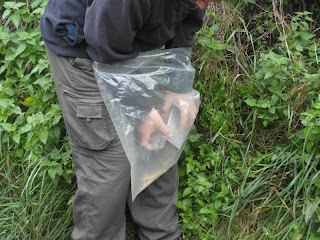Common shrew jawbones. The enamel at the very tips of the teeth is red.
Badger hair: white at the tip, ridged when you roll it between your fingers.
Weighing one of the mammals we trapped.
The Longworth traps are opened inside a bag so the animal doesn't leap away and escape.
Shrew in motion.
I think, going by tail length, we decided this was a pygmy shrew.
Bank vole.
Wood mouse. Scruffing small rodents is the best way to hold them; picking up a wood mouse by its tail can cause the skin to shear away painfully and permanently.
I was lucky enough to attend a Field Studies Centre course this autumn on mammal identification. The FSC run training courses for both amateur and professional ecologists, and cover a wide range of wildlife topics across their various schools: http://www.field-studies-council.org/ My course was at Preston Montford in Shropshire.
We were taught to prepare and set small-mammal traps, the correct way to check them and the proper way to handle and record the wild rodents we caught. We were also shown how to clean the traps after use. We looked at animal prints, nests, skin markings, scat, skulls and feeding signs, and listened to some common mammal calls. We looked at recording and reporting methods; we dissected owl pellets. At the end of the three-day residential course, students were invited to take an exam in Mammal Identification.
I'm delighted to say my certificate came this week and I got a Distinction, with 60 marks out of a maximum 64. So I'm very pleased because I enjoyed the course so much. Now I'm off to join the Mammal Society! http://www.mammal.org.uk/











